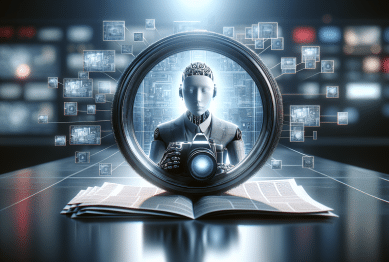Artificial intelligence is quietly rewriting the way news is created, edited, and shared. This guide explores the surprising ways AI impacts journalism, from ethical challenges to boosting fact-checking and uncovering breaking stories faster than ever before.
The Rise of Artificial Intelligence in Newsrooms
Artificial intelligence is rapidly gaining a foothold in newsrooms worldwide. News organizations are turning to AI-powered systems for everything from automating routine reporting to personalizing news feeds. As technology becomes more advanced, digital journalism relies heavily on machine learning and natural language processing to maintain relevance in an ever-shifting media landscape. Automated reporting tools, called ‘robot journalists,’ are already being used to generate weather updates, financial market summaries, and even sports scores, making information delivery remarkably fast and consistent. These shifts not only improve newsroom productivity but also let human journalists focus on in-depth investigative work and unique storytelling angles.
Some major media outlets are experimenting with AI-generated articles for routine tasks and breaking news updates. The Associated Press, for instance, uses AI-driven workflows to cover quarterly earnings reports, freeing up journalistic resources for deeper coverage (Source: https://www.niemanlab.org/2016/02/heres-how-ap-is-using-automation-to-produce-thousands-of-earnings-reports/). These developments demonstrate that artificial intelligence in journalism is not a distant future but a tangible reality. Newsrooms are reimagining old workflows, introducing efficiency, and experimenting with creative formats that AI can support.
For journalists, the integration of AI means adapting to new tools and strategies. Traditional newsroom roles are evolving in response to data-driven content generation, predictive analytics, and smarter research tools. Editors and reporters increasingly partner with data scientists, blurring the lines between technology and journalism. This creates opportunities for innovation, but also raises important debates about accountability, bias, and transparency when algorithms directly impact news content and public discourse.
Automated Fact-Checking and Its Impact on Credibility
Trust in the media is a growing concern, driven by misinformation and fake news circulating online. AI-based fact-checking tools aim to safeguard credibility by scanning news content for accuracy and cross-referencing claims with reliable databases. Machine learning models are now able to flag suspicious information, detect manipulated images, and highlight inconsistent data in near real-time. This automated approach is essential in a world where breaking stories can gain viral traction long before newsrooms can verify every detail manually.
Organizations such as PolitiFact and Full Fact use artificial intelligence to prioritize which statements should be checked first (Source: https://www.poynter.org/fact-checking/2022/artificial-intelligence-fact-checking/). These tools can, for example, search transcripts of political speeches and flag potentially misleading claims. AI-supported verification processes help streamline editorial decision-making and reduce the likelihood of falsehoods slipping into news cycles. However, experts warn that algorithms must be trained carefully to recognize nuances and avoid perpetuating biases inadvertently coded into their models.
Automated fact-checking doesn’t eliminate human involvement but acts as an assistant to journalists and editors. The partnership between human judgment and AI speed improves response times in correcting errors and can even help news outlets stay ahead of misinformation trends. As media consumers demand more accurate and transparent reporting, AI-powered fact-checking has become a cornerstone in the fight for trustworthy journalism.
Personalized News Feeds: How Algorithms Guide What You See
Readers notice that their online news feeds are becoming more personal and relevant. This shift is no accident—algorithms are working behind the scenes to analyze user preferences and browsing patterns. Recommendation engines use AI to curate stories likely to engage individual readers, adjusting suggestions based on previous clicks, time spent reading, and even social media interactions. These systems continuously tune content, hoping to deliver a unique, compelling news experience for each visitor.
While personalization can increase reader satisfaction, it also raises questions about filter bubbles and information diversity. Researchers warn that sophisticated algorithms might unintentionally reinforce existing viewpoints by prioritizing similar articles and limiting exposure to alternative perspectives (Source: https://www.niemanlab.org/2017/07/the-problem-with-personalization-when-news-delivers-only-what-you-want-to-hear/). As the digital landscape expands, platforms must find a balance—ensuring readers are both informed and challenged by a broad range of topics.
Many media outlets now offer ‘custom newsletters’ and adaptive news sections based on AI-curated insights. These innovations let users shape their own information diet, but come with responsibility for critical engagement and source awareness. As artificial intelligence grows more effective at predicting user interests, journalists and technologists must collaborate to preserve the ideals of open, unbiased news discovery, so readers receive not only what they want but what they may need to know.
Challenges and Ethical Dilemmas in AI-driven Journalism
Even as AI enhances news production, it introduces new challenges for ethics and editorial standards. For instance, improper reliance on automated content can result in the spread of errors, lack of context, or unintended bias. Transparency in how AI-generated material is labeled and how editorial oversight is preserved is crucial to maintaining reader trust. Many newsrooms now issue guidelines on algorithmic transparency and accountability, outlining where technology assists and where humans make the final call.
Ethicists and watchdog organizations raise concerns about data privacy, consent, and the impact of news automation on vulnerable communities. AI models are only as fair as their training data; if datasets reflect societal prejudices or omit certain voices, the resulting news output may perpetuate these issues. Maintaining diversity in both coverage and newsrooms becomes even more critical in the age of algorithmic reporting (Source: https://www.oii.ox.ac.uk/news-events/news/ai-in-newsrooms-questions-of-bias-and-accountability/).
Another ethical question surrounds authorship and attribution. Should readers be informed when an article is generated largely by AI? Some outlets now explicitly label such stories and clarify editorial review steps. Clear guidelines promote public understanding and mitigate confusion around where artificial intelligence ends and human journalism begins. Moving forward, ongoing dialogue will shape how AI is used ethically and transparently within the media industry.
AI’s Role in Breaking News: Faster, But With Caveats
AI works quickly. In breaking news situations—such as earthquakes, elections, or pandemics—automated alert systems can scan huge amounts of real-time data for signs of major events. Algorithms monitor social media chatter, official announcements, and public sensor networks, sometimes alerting journalists to unfolding stories before traditional sources. This rapid detection is a powerful asset for keeping the public informed when every second matters.
However, the speed of AI can also compound risks. Fast-moving, automated systems may propagate rumors, misinformation, or unverified reports if not properly filtered by human oversight. Outlets are building increasingly sophisticated vetting procedures to ensure only credible updates reach readers—especially in high-stakes news cycles. Media literacy is essential for audiences to recognize preliminary details from fully vetted news, particularly at the onset of a crisis (Source: https://www.journalism.org/2023/01/11/journalists-and-ai/).
Collaborative workflows, where journalists and AI systems share information, maximize the potential of both. AI excels at data crunching and rapid alerts, while human reporters verify facts, add nuance, and capture the human stories behind the headlines. In this partnership, breaking news coverage stays accurate, immediate, and deeply connected to real-world impacts—offering a compelling model for the future of journalism.
The Future of Journalism: Opportunities and Uncertainties
The marriage of AI and news is far from over. As new advances emerge, journalists find more ways to leverage machine learning for investigative projects, data storytelling, and deeper reader engagement. AI tools are even being explored for language translation, broadening global access to news and supporting multi-lingual reporting. These innovations hold promise for richer, more inclusive journalism, if developed responsibly.
Yet uncertainty lingers. Experts debate how far AI should go in setting editorial priorities or selecting sources. With growth comes the need for industry standards, open research, and thoughtful regulations that ensure both technological progress and journalistic integrity (Source: https://www.americanpressinstitute.org/publications/fact-or-fiction-ai-news/). Ultimately, the most effective newsrooms will combine technological acumen with fundamental reporting skills, allowing machines to assist but not replace human curiosity and ethics.
Media consumers, meanwhile, play a crucial role. By learning about the influence of AI on news and staying vigilant against bias or automation errors, audiences can demand transparency and quality. As artificial intelligence reshapes journalism, the partnership between readers, reporters, and technology will determine who tells the story—and how well those stories reflect a complex, interconnected world.
References
1. Simonite, T. (2020). Here’s how AP is using automation to produce thousands of earnings reports. NiemanLab. Retrieved from https://www.niemanlab.org/2016/02/heres-how-ap-is-using-automation-to-produce-thousands-of-earnings-reports/
2. Funke, D. (2022). Artificial intelligence helps fact-checkers keep up with fast-moving claims. Poynter. Retrieved from https://www.poynter.org/fact-checking/2022/artificial-intelligence-fact-checking/
3. Bui, L. (2017). The problem with personalization: When news delivers only what you want to hear. NiemanLab. Retrieved from https://www.niemanlab.org/2017/07/the-problem-with-personalization-when-news-delivers-only-what-you-want-to-hear/
4. Oxford Internet Institute. (2019). AI in newsrooms: Questions of bias and accountability. OII News. Retrieved from https://www.oii.ox.ac.uk/news-events/news/ai-in-newsrooms-questions-of-bias-and-accountability/
5. Pew Research Center. (2023). Journalists and artificial intelligence. Retrieved from https://www.journalism.org/2023/01/11/journalists-and-ai/
6. American Press Institute. (n.d.). Fact or fiction? AI in newsrooms. Retrieved from https://www.americanpressinstitute.org/publications/fact-or-fiction-ai-news/









